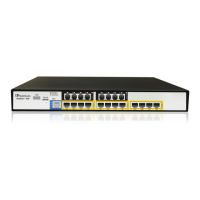• Set DSCP: Select this check box if you want to change the DSCP value
(hexadecimal) on packets matching the rule, prior to routing them further.
• Set Priority: Select this check box if you want to change a priority (where zero is
the lowest and seven the highest) of the packets matching the rule. Each priority
level is assigned a default queue number, where Queue 0 has the lowest priority.
The device's QoS supports up to eight queues. The matching between a priority
level and a queue number can be edited in the '802.1p Settings page (see
'Configuring 802.1p Settings' on page 559).
• Set Tx Class Name: Select the check box and then from the drop-down list,
select the defined Tx Class.
• Apply QoS on: Select whether to apply QoS on a connection or just the first
packet. When applying on a connection, the data transfer session is handled
using Stateful Packet Inspection (SPI). This means that other packets matching
this rule are automatically allowed to access, and the same QoS scheme is
applied to them.
5. Under the 'Logging' group, select the 'Log Packets Matched by This Rule' to log the
first packet from a connection that was matched by this rule.
6. Click OK to save your changes.
The order of appearance of the rules represents both the order in which they were defined
and the sequence by which they are applied. You may change this order, by using the
Move Up and Move Down icons.
42.3 Configuring Traffic Shaping
Traffic shaping allows you to define Tx (transmission) traffic classes for all the LAN and
WAN interfaces. These traffic shaping classes can later be assigned to matching packet
priority rules (defined in 'Configuring Matching Rules' on page 551).
Traffic Shaping allows you to manage and avoid congestion where a high speed LAN
meets limited broadband bandwidth. A user may have, for example, a 100 Mbps Ethernet
LAN with a 100 Mbps WAN interface router. The router may communicate with the ISP
using a modem with a bandwidth of 2 Mbps. This typical configuration makes the modem,
having no QoS module, the bottleneck.
The router sends traffic as fast as it is received, while its well-designed QoS algorithms are
left unused. Traffic shaping limits the bandwidth of the router, artificially forcing the router to
be the bottleneck. A traffic shaper is essentially a regulated queue that accepts uneven
and/or bursty flows of packets and transmits them in a steady, predictable stream so that
the network is not overwhelmed with traffic. While Traffic Priority allows basic prioritization
of packets, Traffic Shaping provides more sophisticated definitions, such as the following:
TCP serialization on a device
The bandwidth of a device can be divided to reserve constant portions of bandwidth to
predefined traffic types. Such a portion is known as a Traffic Class. When not used by its
predefined traffic type, or owner (for example VoIP), the bandwidth is available to all other
traffic. However when needed, the entire class is reserved solely for its owner. Moreover,
you can limit the maximum bandwidth that a class can use even if the entire bandwidth is
available. When a shaping class is first defined for a specific traffic type, two shaping
classes are created. The second class is the 'Default Class', which is responsible for all the
packets that do not match the defined shaping class, or any other classes that may be
defined on the device.

